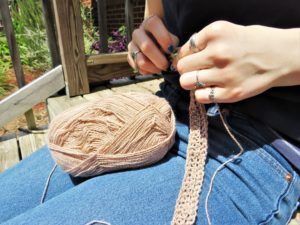by Jessica Frierson, August 2021
 Of the many reasons our family chose to homeschool, creativity is my favorite. Unlike traditional classrooms, the homeschool environment is particularly conducive to encouraging and inspiring creativity. Just as in a greenhouse where tender plants are coaxed and nourished with the goal of bearing luscious fruit or beautiful flowers, our children’s education is nurtured to bring out the hidden talents and skills within them.
Of the many reasons our family chose to homeschool, creativity is my favorite. Unlike traditional classrooms, the homeschool environment is particularly conducive to encouraging and inspiring creativity. Just as in a greenhouse where tender plants are coaxed and nourished with the goal of bearing luscious fruit or beautiful flowers, our children’s education is nurtured to bring out the hidden talents and skills within them.
Many people limit the concept of creativity to areas of the arts. Others might define it as imagination. Richard Foster, Yale lecturer and emeritus director of McKinsey & Company, has made a study of creativity, concluding that it is about making something new. “When you find one creative idea,” he says, “more often than not it triggers other ideas in the same fashion.” Homeschool parents commonly see this domino effect when their children are permitted to explore their interests and encouraged to follow the ideas they devise in the free environment homeschooling provides.
Foster continues, “A key to being creative is the ability to find associations between different fields of knowledge, especially ones that appear radically different at first.” This thought is a wonderful description of the popular homeschool method of unit studies. Unit studies are available on a myriad of subjects, but our personal family favorites have begun with my children asking questions about one topic that led to another. Trips to the library, streaming videos, and stacks of books later, we often complete our spontaneous investigation with a family presentation. The creative juices stirred up may result in art projects, LEGO constructions, a re-enactment with Playmobil, or a PowerPoint slideshow. The current theme of our school week is often evidenced by the apparel my younger children devise for themselves. It is not unusual to see a tribe of Indians, a group of Pilgrims, a company of soldiers, or a menagerie of “animals” running through our yard. My thoughts of “What will the neighbors think?” were dispelled when one confided in me that they were quite envious of the adventurous schooling my children experienced and the joy it brought as they observed it.
David Elkind, a renowned psychologist, emphasizes the value of creative play. “Decades of research has shown that play is crucial to physical, intellectual, and social-emotional development at all ages. This is especially true of the purest form of play: the unstructured, self-motivated, imaginative, independent kind, where children initiate their own games and even invent their own rules.”
The biological explanation for creativity is shared by Dr. Jonathan Fineberg of the University of the Arts in Philadelphia: “Humans take in so much information from the world around us—sights, smells, sounds, and more. Creativity is about being able to put those pieces together in a new way.” Free from classroom restrictions—sit still, line up, don’t talk without raising your hand, keep your thoughts to yourself—the homeschool student can freely process information and give impetus to inspiration as it hits. As they turn from studies to play, the knowledge learned is reorganized in their minds and spurs them on to create new ideas using that knowledge.
Research backs this up, and studies done to compare the levels of creativity of homeschoolers to their public school counterparts showed superiority on all three kinds of creativity measured in the homeschooled students. In fact, the creativity displayed in math concepts increased in relation to the number of years the children were homeschooled. Researchers believe the reason for that lies in that the teaching methods employed by the homeschool parent “promote math creativity by encouraging independence and a game-like approach to problem-solving.”
When presenting new math concepts with my children, I often turn them into a game; it makes it more enjoyable and creates a sense of intrigue in their minds as they are working on the problems. As they look beyond the numbers on the page, their interest is aroused, and they are motivated to investigate for themselves how math works in the world around them. In today’s technology-centered world, creativity in math and science is a more valuable commodity than rote memorization of facts.
Another advantage of the home classroom is the freedom to move around frequently. What would be disruptive in a conventional classroom is normal activity in a home. Not only is this much more enjoyable for children, but it also has a correlation with their academic achievement. Math and reading are affected by physical activity because they depend on efficient, effective executive function, which is enhanced with physical activity, as noted by the National Institute of Health.
A common critique of homeschooling is that the child will miss out on so many opportunities. Ironically, with cuts that schools have made in things like recess, music, art, and physical education, many homeschooled students have an abundance of creative outlets unavailable to them in a conventional school. Freedom from the constraints necessary in an institutional setting opens the doors wide for creative expression. The fruit of this may be revealed in a beautiful work of art, a tasty culinary concoction, the development of a computer app—or maybe even a future medical breakthrough! There is no limit to the depth of creative potential residing in our children’s minds so let us not limit their pathways to discovery.




